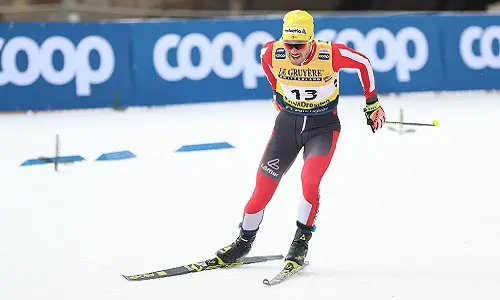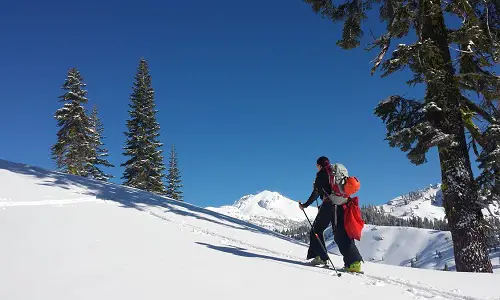Table of Contents
The average skiing speed varies depending on the type of the skier, conditions they are skiing in, their body composition and the equipment they are using – the fastest ones pointing their skis in a straight downhill position on a steep slope, and without turning.
Recreational classic cross-country skiers speed ranges between 7-10 mph, while professional cross-country ski racers reach an average of 15 mph on a 35 miles long distance. Top XC ski racers usually achieve speed around 20-25 mph on flat and even 35-40 mph on downhills. Meanwhile, skate or freestyle cross-country skiers are generally faster by 10%. Speed is also affected by external conditions, such as extreme cold which can accelarate classic skis to be as fast as their skating counterparts.
Classic Skiing
Classic ski trails (usually two parallel tracks) allow avid skiers to glide through the breathtaking snowy landscapes with the assistance of classic skis. Classic cross-country skiing offers the optimum natural movement on skis.
The technique for this form of skiing is akin to walking; the only addition is that you have skis on your feet and poles in both your hands. The key aspect of this technique involves a short kick, or pushing the “kick zone” right into the snow. These push movements create friction in turn and help you to stay balanced and glide forward. The speed can be adjusted by the skier by either going easy on the kick zone or pushing harder to reach high speeds.
Classic skiing is the first recommendation that any professional will offer, when asked. The reason is that it is easier to execute and learn as a beginner. There is an exception though, and that is when you are using roller skis, as opposed to on-snow skiing. If that is the case, then you are better off starting with skate skiing.

There is a steeper learning curve when it comes to learning the basics of skate skiing, but it isn’t that difficult if you put the time and effort into it. If you have access to trails that can accommodate both styles of skiing, then you have a choice and can opt for whatever you prefer.
Skate skiing is generally opted by younger professionals and athletes who find this form of skiing as a challenging training experience during winter months.
If you can afford (in terms of time, money and interest) to do both the classic and skating skiing, then nothing beats the fun. The best aspect about joining these two styles is that there is an element of skills transferability and this helps you holistically to improve as a skier. When you are interested in both these forms of skiing then you are naturally meant to have both skate and classic equipment. This affords you with higher flexibility as you can choose the preferred style based on your mood, weather and grooming conditions.
Skating
Skating can guarantee the users with tons of fun and super speeds. The level of guidance that you get in classic cross country skiing is not the same in skating and that is the reason it is called “free technique”.
V-style is the key to learning the skating technique. The ski’s edges are pushed into the snow hard to create speed, and then the body weight gets transferred to the other ski that enables you to glide. It is this gliding component that makes skate skiing fast (up to 30km/h on wide trails, with good technique and light skiing gear) and thrilling. Once you have learned this complex technique, you won’t be troubled by the steep uphill sections or sharp turns on the trail. It is kind of addictive and you would like to spend most part of your day, training out in the snow.
Skate skis, (similar to classic skis) come with a bow-like construction (camber), but without a grip zone, as the skis glide on the snow consistently.
The skate skis are used in a V-shape (as opposed to being parallel) with the ski tips angled wider apart than its tails. Skate skis are shorter in size than classic skis, and hence, are more manageable with the feet in a V-position.
To enable the forward movement, only one ski needs to be rolled at a time and onto the inside edge and then pushed sideways. The technique is quite similar to ice skating; however, the mechanics can vary due to the different between ice skates and skiing skates and also between the snow and the ice.
Skate boots are different than classic boots. They are stiffer and come with cuffs that help the skier with stabilizing their feet and ankles. This is enabled by the longer poles that come standard with skate boots, as compared to classic poles. In both the classic and skating skiing, the ski poles are vital in moving the skier forward.
The skate skiing has challenging technique and can be an exhausting option for novice skiers, as opposed to classic skiing, where new users can be sloppy with walking or shuffling their skis to glide ahead. Regardless of the level, skate skiing demands full body coordination and superb balance for optimum performance.
Skate skiing can be performed best on machine groomed trails or a thick snow crusted surfaces. You simply cannot execute skate skiing on deep or ungroomed snow surfaces. Skate skiing is also not advisable under extreme or inclement weather or temperature conditions (cold or warm) due to the slowness of the snow surface that makes gliding difficult.
You can extract much higher speeds and can be more in control on the downhill, when you are skate skiing, as compared to classic.
Back-Country

Backcountry cross-country skiing provides you with real freedom on the skis. The backcountry ski is a perfect gear for those looking to ski off tracks, or for full day trips, when you are carrying a small backpack or with cabin trips.
The skis in the backcountry range can help skiers access multiple terrains, as they are built lightly and have sturdy metal edges. One of the best features of backcountry skiing is the agility and safety it affords even when skiing on lower mountain ranges or fields, and in all types of snow conditions.
The characteristics of backcountry movement are almost similar to classic skiing, particularly with the kick and glide parts, as the skis are positioned in a parallel position. It is to be noticed that backcountry skis will offer you maximum comfort in deep and fresh snow conditions, and not so much in parallel tracks.
Backcountry skiing is also one of the most original types of Nordic Skiing and has quite a fan base in Scandinavia. It is often termed as “real cross-country skiing” that lets you step out of your door and pass through multiple landscapes involving fields, valleys, and woods.
Racing
A lot of skiers that you bump into the trails will often be self-taught or would have taken a few basic skiing lessons. You will notice them shuffling their classic skis as they imitate walking on a normal surface. You will also see them with skate skis, using similar technique across all terrains.
Then there are skiers who have sounder technical skills, and that can be blatantly obvious with their maneuvers, as they glide swiftly and in an effortless manner – transitioning between different terrains and employing different techniques.
The terms “recreational” and “performance” or “race” are often used casually to differentiate between these types of skiers.
These racing skiers can technically be described as beginners when it comes to the sport of skiing, but they do display potential and certain skill set that should motivate them enough to get polished as a competitive-style cross-country skier. It is challenging but eventually gives you the rewards and promises tons of fun along the way.
Race technique allows a lot more people to take up this sport, but fall short of proper comprehension of the skills.
Conclusion
There are a couple of good options that allow the monitoring of speeds for downhill skiers– speedometer from the sidelines or using a smart phone or smart watch skiing app that tracks and displays distance travelled, speed as well as vertical feet.
If you intend to travel at faster speeds during downhill, then you need to work on your core strength first to get a better control of your skis, as well as developing proper skiing techniques.
Skiers who are planning to go downhill at higher speeds should always wear appropriate safety gear as the probability of an accident or injuries are higher at that pace.
No matter where and when you ski, always be mindful of the rules, in particular, those associated with the speed limits of skiing – avoiding faster speeds during bad light, unpredictable or inclement weather conditions and ensuring that you and the fellow skiers remain safe and comfortable around each other at all times.
This guide aims to assist new cross-country skiers with some basic skiing techniques and the speeds that they can achieve or expect to achieve when engaging in downhill XC skiing. We hope you found this helpful and wish you can ‘learn the slopes’ sooner and better with the right skill set.


